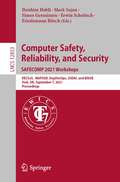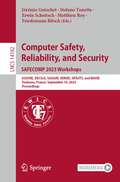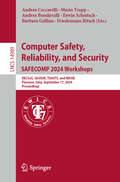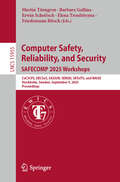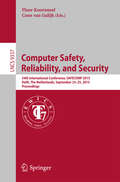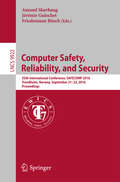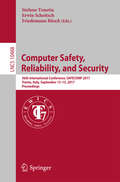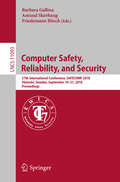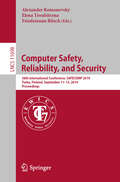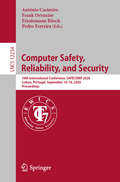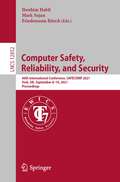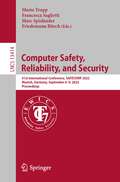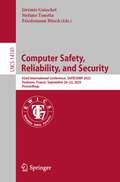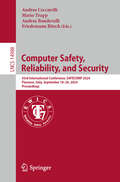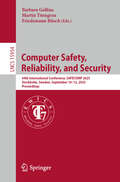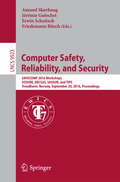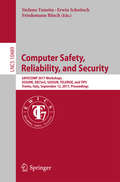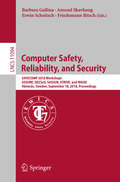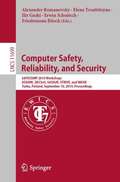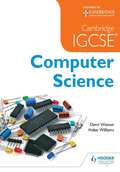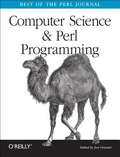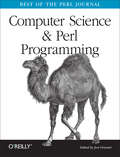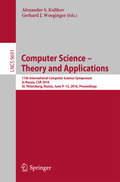- Table View
- List View
Computer Safety, Reliability, and Security. SAFECOMP 2021 Workshops: DECSoS, MAPSOD, DepDevOps, USDAI, and WAISE, York, UK, September 7, 2021, Proceedings (Lecture Notes in Computer Science #12853)
by Friedemann Bitsch Erwin Schoitsch Ibrahim Habli Mark Sujan Simos GerasimouThis book constitutes the proceedings of the Workshops held in conjunction with SAFECOMP 2021, the 40th International Conference on Computer Safety, Reliability and Security, which took place in York, UK, in September 2021. The 26 regular papers included in this volume were carefully reviewed and selected from 34 submissions. The workshops included in this volume are: DECSoS 2021: 16th Workshop on Dependable Smart Embedded and Cyber-Physical Systems and Systems-of-SystemsWAISE 2021: Fourth International Workshop on Artificial Intelligence Safety EngineeringDepDevOps 2021: Second International Workshop on Dependable Development-Operation Continuum Methods for Dependable Cyber-Physical SystemsUSDAI 2021: Second International Workshop on Underpinnings for Safe Distributed AI MAPSOD 2021: First International Workshop on Multi-concern Assurance Practices in Software Design
Computer Safety, Reliability, and Security. SAFECOMP 2023 Workshops: ASSURE, DECSoS, SASSUR, SENSEI, SRToITS, and WAISE, Toulouse, France, September 19, 2023, Proceedings (Lecture Notes in Computer Science #14182)
by Jérémie Guiochet Friedemann Bitsch Erwin Schoitsch Stefano Tonetta Matthieu RoyThis book constitutes the proceedings of the Workshops held in conjunction with SAFECOMP 2023, held in Toulouse, France, during September 19, 2023.The 35 full papers included in this volume were carefully reviewed and selected from 49 submissions. - - 8th International Workshop on Assurance Cases for Software-intensive Systems (ASSURE 2023)- - 18th International Workshop on Dependable Smart Embedded and Cyber-Physical Systems and Systems-of-Systems (DECSoS 2023)- - 10th International Workshop on Next Generation of System Assurance Approaches for Critical Systems (SASSUR 2023)- - Second International Workshop on Security and Safety Interactions (SENSEI 2023)- - First International Workshop on Safety/ Reliability/ Trustworthiness of Intelligent Transportation Systems (SRToITS 2023) - - 6th International Workshop on Artificial Intelligence Safety Engineering (WAISE 2023)
Computer Safety, Reliability, and Security. SAFECOMP 2024 Workshops: DECSoS, SASSUR, TOASTS, and WAISE, Florence, Italy, September 17, 2024, Proceedings (Lecture Notes in Computer Science #14989)
by Friedemann Bitsch Erwin Schoitsch Andrea Bondavalli Barbara Gallina Andrea Ceccarelli Mario TrappThis book constitutes the proceedings of the Workshops held in conjunction with the 43rd International Conference on Computer Safety, Reliability, and Security, SAFECOMP 2024, which took place in Florence, Italy, during September 2024. The 36 papers included in this book were carefully reviewed and selected from a total of 64 submissions to the following workshops: DECSoS 2024 – 19th Workshop on Dependable Smart Embedded and Cyber-Physical Systems and Systems-of-Systems SASSUR 2024 - 11th International Workshop on Next Generation of System Assurance Approaches for Critical Systems TOASTS 2024 – Towards A Safer Systems’ Architecture Through Security WAISE 2024 – 7th International Workshop on Artificial Intelligence Safety Engineering
Computer Safety, Reliability, and Security. SAFECOMP 2025 Workshops: CoC3CPS, DECSoS, SASSUR, SENSEI, SRToITS, and WAISE, Stockholm, Sweden, September 9, 2025, Proceedings (Lecture Notes in Computer Science #15955)
by Friedemann Bitsch Erwin Schoitsch Elena Troubitsyna Barbara Gallina Martin TörngrenThis book constitutes the proceedings of the Workshops held in conjunction with the 44th International Conference on Computer Safety, Reliability, and Security, SAFECOMP 2025, which took place in Stockholm, Sweden, during September 2025. The 43 papers included in this book were carefully reviewed and selected from a total of 61 submissions to the following six workshops: · CoC3CPS 2025, Co-Design of Communication, Computing and Control in Cyber-Physical Systems · DECSoS 2025 – 20th Workshop on Dependable Smart Embedded and Cyber-Physical Systems and Systems-of-Systems · SASSUR 2025 - 12th International Workshop on Next Generation of System Assurance Approaches for Critical Systems · SENSEI 2025 – 4th International Workshop on Safety and Security Interaction · SRToITS 2025 – 2nd International Workshop on Safety/Reliability/Trustworthiness of Intelligent Transportation Systems ·<span style="font: 7
Computer Safety, Reliability, and Security: 34th International Conference, SAFECOMP 2015, Delft, The Netherlands, September 23-25, 2015, Proceedings (Lecture Notes in Computer Science #9337)
by Floor Koornneef Coen Van GulijkThis book constitutes the refereed proceedings of the 34th International Conference on Computer Safety, Reliability, and Security, SAFECOMP 2015, held in Delft, The Netherlands, in September 2014. The 32 revised full papers presented together with 3 invited talks were carefully reviewed and selected from 104 submissions. The papers are organized in topical sections on flight systems, automotive embedded systems, automotive software, error detection, medical safety cases, medical systems, architecture and testing, safety cases, security attacks, cyber security and integration, and programming and compiling.
Computer Safety, Reliability, and Security: 35th International Conference, SAFECOMP 2016, Trondheim, Norway, September 21-23, 2016, Proceedings (Lecture Notes in Computer Science #9922)
by Amund Skavhaug Jérémie Guiochet Friedemann BitschThis book constitutes the refereed proceedings of the 32nd International Conference on Computer Safety, Reliability, and Security, SAFECOMP 2013, held in Toulouse, France, in September 2013. The 20 revised full papers presented together with 5 practical experience reports were carefully reviewed and selected from more than 88 submissions. The papers are organized in topical sections on safety requirements and assurance, testing and verification, security, software reliability assessment, practical experience reports and tools, safety assurance in automotive, error control codes, dependable user interfaces, and hazard and failure mode analysis.
Computer Safety, Reliability, and Security: 36th International Conference, SAFECOMP 2017, Trento, Italy, September 13-15, 2017, Proceedings (Lecture Notes in Computer Science #10488)
by Friedemann Bitsch Erwin Schoitsch Stefano TonettaSAFECOMP '96 contains papers presented at the 15th International Conference on Computer Safety, Reliability and Security held in Vienna, Austria, 23-25 October 1996. The conference aimed to provide an opportunity for technical developers and users to discuss and review their experiences, to consider the best technologies currently available, and to identify the skills and technologies required for the future. SAFECOMP '96 focuses on critical computer applications and is intended as a platform for technology transfer between academia, industry and research institutions. SAFECOMP '96 will be of interest to all those in universities, research institutions, industry and business who want to be well-informed about the current international state of the art in computer safety, reliability and security.
Computer Safety, Reliability, and Security: 37th International Conference, SAFECOMP 2018, Västerås, Sweden, September 19-21, 2018, Proceedings (Lecture Notes in Computer Science #11093)
by Amund Skavhaug Friedemann Bitsch Barbara GallinaThis book constitutes the refereed proceedings of the 37th International Conference on Computer Safety, Reliability, and Security, SAFECOMP 2018, held in Västerås, Sweden, in September 2018. The 19 revised full papers and 1 short paper presented together with three abstracts of keynotes were carefully reviewed and selected from 63 submissions. The papers are organized in topical sections on Automotive Safety Standards and Cross-domain Reuse Potential; Autonomous Driving and Safety Analysis; Verification; Multi-concern Assurance; Fault Tolerance; and Safety and Security Risk.
Computer Safety, Reliability, and Security: 38th International Conference, SAFECOMP 2019, Turku, Finland, September 11–13, 2019, Proceedings (Lecture Notes in Computer Science #11698)
by Alexander Romanovsky Friedemann Bitsch Elena TroubitsynaThis book constitutes the proceedings of the 38th International Conference on Computer Safety, Reliability and Security, SAFECOMP 2019, held in Turku, Finland, in September 2019. The 16 full and 5 short papers included in this volume were carefully reviewed and selected from 65 submissions. They were organized in topical sections named: formal verification; autonomous driving; safety and reliability modeling; security engineering and risk assessment; safety argumentation; verification and validation of autonomous systems; and interactive systems and design validation.
Computer Safety, Reliability, and Security: 39th International Conference, SAFECOMP 2020, Lisbon, Portugal, September 16–18, 2020, Proceedings (Lecture Notes in Computer Science #12234)
by Friedemann Bitsch Pedro Ferreira António Casimiro Frank OrtmeierThis book constitutes the proceedings of the 39th International Conference on Computer Safety, Reliability and Security, SAFECOMP 2020, held in Lisbon, Portugal, in September 2020.*The 27 full and 2 short papers included in this volume were carefully reviewed and selected from 116 submissions. They were organized in topical sections named: safety cases and argumentation; formal verification and analysis; security modelling and methods; assurance of learning-enabled systems; practical experience and tools; threat analysis and risk mitigation; cyber-physical systems security; and fault injection and fault tolerance. *The conference was held virtually due to the COVID-19 pandemic.The chapter ‘Assurance Argument Elements for Off-the-Shelf, Complex Computational Hardware’ is available open access under an Open Government License 3.0 via link.springer.com.
Computer Safety, Reliability, and Security: 40th International Conference, SAFECOMP 2021, York, UK, September 8–10, 2021, Proceedings (Lecture Notes in Computer Science #12852)
by Friedemann Bitsch Ibrahim Habli Mark SujanThis book constitutes the proceedings of the 40th International Conference on Computer Safety, Reliability and Security, SAFECOMP 2021, which took place in York, UK, in September 2021.The 17 full papers included in this volume were carefully reviewed and selected from 76 submissions. They were organized in topical sections as follows: machine learning safety assurance; security engineering; safety and assurance cases; machine learning applications; safety validation and simulation; and fault tolerance.
Computer Safety, Reliability, and Security: 41st International Conference, SAFECOMP 2022, Munich, Germany, September 6–9, 2022, Proceedings (Lecture Notes in Computer Science #13414)
by Friedemann Bitsch Francesca Saglietti Mario Trapp Marc SpisländerThis book constitutes the proceedings of the 41st International Conference on Computer Safety, Reliability and Security, SAFECOMP 2022, which took place in Munich, Germany, in September 2022.The 24 full papers included in this volume were carefully reviewed and selected from 93 submissions. SafeComp has contributed to the progress of the state-of-the-art in dependable application of computers in safety-related and safety-critical systems. SafeComp is an annual event covering the state-of-the-art, experience and new trends in the areas of safety, security and reliability of critical computer applications.
Computer Safety, Reliability, and Security: 42nd International Conference, SAFECOMP 2023, Toulouse, France, September 20–22, 2023, Proceedings (Lecture Notes in Computer Science #14181)
by Jérémie Guiochet Friedemann Bitsch Stefano TonettaThis book constitutes the refereed proceedings of the 42nd International Conference on Computer Safety, Reliability and Security, SAFECOMP 2023, which took place in Toulouse, France, in September 2023.The 20 full papers included in this volume were carefully reviewed and selected from 100 submissions. They were organized in topical sections as follows: Safety assurance; software testing and reliability; neural networks robustness and monitoring; model-based security and threat analysis; safety of autonomous driving; security engineering; AI safety; and neural networks and testing.
Computer Safety, Reliability, and Security: 43rd International Conference, SAFECOMP 2024, Florence, Italy, September 18–20, 2024, Proceedings (Lecture Notes in Computer Science #14988)
by Friedemann Bitsch Andrea Bondavalli Andrea Ceccarelli Mario TrappThis book constitutes the refereed proceedings of the 43rd International Conference on Computer Safety, Reliability and Security, SAFECOMP 2024, held in Florence, Italy, in September 2024. The 19 full papers included in this volume were carefully reviewed and selected from 80 submissions. They have been organized in topical sections as follows: Fault Injection and Tolerance; System and Software Safety Assurance; Automated Driving Systems; Security of safety-critical systems; Safety Verification; and Autonomous Systems.
Computer Safety, Reliability, and Security: 44th International Conference, SAFECOMP 2025, Stockholm, Sweden, September 10–12, 2025, Proceedings (Lecture Notes in Computer Science #15954)
by Friedemann Bitsch Barbara Gallina Martin TörngrenThis book constitutes the refereed proceedings of the 44th International Conference on Computer Safety, Reliability and Security, SAFECOMP 2025, held in Stockholm, Sweden, during September 2025. The 15 full papers included in these proceedings were carefully reviewed and selected from 79 submissions. They were organized in topical sections as follows: Safety Arguments/Cases; Data Sets and Dependability Properties; Testing and Complex Environments; Methodologies (1) - Safety Design and Risk Assessment; and Methodologies (2) Machine Learning and Large Language.
Computer Safety, Reliability, and Security: SAFECOMP 2015 Workshops, ASSURE, DECSoS. ISSE, ReSA4CI, and SASSUR, Delft, The Netherlands, September 22, 2015, Proceedings (Lecture Notes in Computer Science #9338)
by Floor Koornneef Coen Van GulijkThis book constitutes the refereed proceedings of the 34th International Conference on Computer Safety, Reliability, and Security, SAFECOMP 2015, held in Delft, The Netherlands, in September 2014. The 32 revised full papers presented together with 3 invited talks were carefully reviewed and selected from 104 submissions. The papers are organized in topical sections on flight systems, automotive embedded systems, automotive software, error detection, medical safety cases, medical systems, architecture and testing, safety cases, security attacks, cyber security and integration, and programming and compiling.
Computer Safety, Reliability, and Security: SAFECOMP 2016 Workshops, ASSURE, DECSoS, SASSUR, and TIPS, Trondheim, Norway, September 20, 2016, Proceedings (Lecture Notes in Computer Science #9923)
by Amund Skavhaug Jérémie Guiochet Friedemann Bitsch Erwin SchoitschSAFECOMP '96 contains papers presented at the 15th International Conference on Computer Safety, Reliability and Security held in Vienna, Austria, 23-25 October 1996. The conference aimed to provide an opportunity for technical developers and users to discuss and review their experiences, to consider the best technologies currently available, and to identify the skills and technologies required for the future. SAFECOMP '96 focuses on critical computer applications and is intended as a platform for technology transfer between academia, industry and research institutions. SAFECOMP '96 will be of interest to all those in universities, research institutions, industry and business who want to be well-informed about the current international state of the art in computer safety, reliability and security.
Computer Safety, Reliability, and Security: SAFECOMP 2017 Workshops, ASSURE, DECSoS, SASSUR, TELERISE, and TIPS, Trento, Italy, September 12, 2017, Proceedings (Lecture Notes in Computer Science #10489)
by Friedemann Bitsch Erwin Schoitsch Stefano TonettaSAFECOMP '96 contains papers presented at the 15th International Conference on Computer Safety, Reliability and Security held in Vienna, Austria, 23-25 October 1996. The conference aimed to provide an opportunity for technical developers and users to discuss and review their experiences, to consider the best technologies currently available, and to identify the skills and technologies required for the future. SAFECOMP '96 focuses on critical computer applications and is intended as a platform for technology transfer between academia, industry and research institutions. SAFECOMP '96 will be of interest to all those in universities, research institutions, industry and business who want to be well-informed about the current international state of the art in computer safety, reliability and security.
Computer Safety, Reliability, and Security: SAFECOMP 2018 Workshops, ASSURE, DECSoS, SASSUR, STRIVE, and WAISE, Västerås, Sweden, September 18, 2018, Proceedings (Lecture Notes in Computer Science #11094)
by Amund Skavhaug Friedemann Bitsch Erwin Schoitsch Barbara GallinaThis book constitutes the refereed proceedings of five workshops co-located with SAFECOMP 2018, the 37th International Conference on Computer Safety, Reliability, and Security, held in Västerås, Sweden, in September 2018. The 28 revised full papers and 21 short papers presented together with 5 introductory papers to each workshop were carefully reviewed and selected from 73 submissions. This year's workshops are: ASSURE 2018 – Assurance Cases for Software-Intensive Systems; DECSoS 2018 – ERCIM/EWICS/ARTEMIS Dependable Smart Embedded and Cyber-Physical Systems and Systems-of-Systems; SASSUR 2018 – Next Generation of System Assurance Approaches for Safety-Critical Systems; STRIVE 2018 – Safety, securiTy, and pRivacy In automotiVe systEms; and WAISE 2018 – Artificial Intelligence Safety Engineering.The chapter '“Boxing Clever”: Practical Techniques for Gaining Insights into Training Data and Monitoring Distribution Shift' is available open access under an Open Government License via link.springer.com.
Computer Safety, Reliability, and Security: SAFECOMP 2019 Workshops, ASSURE, DECSoS, SASSUR, STRIVE, and WAISE, Turku, Finland, September 10, 2019, Proceedings (Lecture Notes in Computer Science #11699)
by Alexander Romanovsky Friedemann Bitsch Erwin Schoitsch Elena Troubitsyna Ilir GashiThis book constitutes the proceedings of the Workshops held in conjunction with SAFECOMP 2019, 38th International Conference on Computer Safety, Reliability and Security, in September 2019 in Turku, Finland. The 32 regular papers included in this volume were carefully reviewed and selected from 43 submissions; the book also contains two invited papers. The workshops included in this volume are: ASSURE 2019: 7th International Workshop on Assurance Cases for Software-Intensive Systems DECSoS 2019: 14th ERCIM/EWICS/ARTEMIS Workshop on Dependable Smart Embedded and Cyber-Physical Systems and Systems-of-Systems SASSUR 2019: 8th International Workshop on Next Generation of System Assurance Approaches for Safety-Critical Systems STRIVE 2019: Second International Workshop on Safety, securiTy, and pRivacy In automotiVe systEms WAISE 2019: Second International Workshop on Artificial Intelligence Safety Engineering
Computer Science
by David Watson Helen WilliamsA student workbook to support the students throughout their Cambridge IGCSE Computer Science course, with plenty of extra practice questions and activities. It accompanies the Cambridge IGCSE Computer Science student text book, following the contents and chapter order.
Computer Science & Perl Programming
by O'Reilly MediaIn its first five years of existence, The Perl Journal ran 247 articles by over 120 authors. Every serious Perl programmer subscribed to it, and every notable Perl guru jumped at the opportunity to write for it. TPJ explained critical topics such as regular expressions, databases, and object-oriented programming, and demonstrated Perl's utility for fields as diverse as astronomy, biology, economics, AI, and games. The magazine gave birth to both the Obfuscated Perl Contest and the Perl Poetry contest, and remains a proud and timeless achievement of Perl during one of its most exciting periods of development. Computer Science and Perl Programming is the first volume of The Best of the Perl Journal, compiled and re-edited by the original editor and publisher of The Perl Journal, Jon Orwant. In this series, we've taken the very best (and still relevant) articles published in TPJ over its 5 years of publication and immortalized them into three volumes. This volume has 70 articles devoted to hard-core computer science, advanced programming techniques, and the underlying mechanics of Perl. Here's a sample of what you'll find inside: Jeffrey Friedl on Understanding Regexes Mark Jason Dominus on optimizing your Perl programs with Memorization Damian Conway on Parsing Tim Meadowcroft on integrating Perl with Microsoft Office Larry Wall on the culture of Perl Written by 41 of the most prominent and prolific members of the closely-knit Perl community, this anthology does what no other book can, giving unique insight into the real-life applications and powerful techniques made possible by Perl. Other books tell you how to use Perl, but this book goes far beyond that: it shows you not only how to use Perl, but what you could use Perl *for*. This is more than just The Best of the Perl Journal -- in many ways, this is the best of Perl.
Computer Science & Perl Programming: Best of The Perl Journal
by Jon OrwantIn its first five years of existence, The Perl Journal ran 247 articles by over 120 authors. Every serious Perl programmer subscribed to it, and every notable Perl guru jumped at the opportunity to write for it. TPJ explained critical topics such as regular expressions, databases, and object-oriented programming, and demonstrated Perl's utility for fields as diverse as astronomy, biology, economics, AI, and games. The magazine gave birth to both the Obfuscated Perl Contest and the Perl Poetry contest, and remains a proud and timeless achievement of Perl during one of its most exciting periods of development.Computer Science and Perl Programming is the first volume of The Best of the Perl Journal, compiled and re-edited by the original editor and publisher of The Perl Journal, Jon Orwant. In this series, we've taken the very best (and still relevant) articles published in TPJ over its 5 years of publication and immortalized them into three volumes. This volume has 70 articles devoted to hard-core computer science, advanced programming techniques, and the underlying mechanics of Perl.Here's a sample of what you'll find inside:Jeffrey Friedl on Understanding RegexesMark Jason Dominus on optimizing your Perl programs with MemoizationDamian Conway on ParsingTim Meadowcroft on integrating Perl with Microsoft OfficeLarry Wall on the culture of PerlWritten by 41 of the most prominent and prolific members of the closely-knit Perl community, this anthology does what no other book can, giving unique insight into the real-life applications and powerful techniques made possible by Perl.Other books tell you how to use Perl, but this book goes far beyond that: it shows you not only how to use Perl, but what you could use Perl for. This is more than just The Best of the Perl Journal -- in many ways, this is the best of Perl.
Computer Science - Theory and Applications: 11th International Computer Science Symposium in Russia, CSR 2016, St. Petersburg, Russia, June 9-13, 2016, Proceedings (Lecture Notes in Computer Science #9691)
by Alexander S. Kulikov Gerhard J. WoegingerThis book constitutes the proceedings of the 11th International Computer Science Symposium in Russia, CSR 2016, held in St. Petersburg, Russia, in June 2016. The 28 full papers presented in this volume were carefully reviewed and selected from 71 submissions. In addition the book contains 4 invited lectures. The scope of the proposed topics is quite broad and covers a wide range of areas such as: include, but are not limited to: algorithms and data structures; combinatorial optimization; constraint solving; computational complexity; cryptography; combinatorics in computer science; formal languages and automata; computational models and concepts; algorithms for concurrent and distributed systems, networks; proof theory and applications of logic to computer science; model checking; automated reasoning; and deductive methods.
Computer Science Education Research
by Marian Petre Sally FincherThis book provides an overview of how to approach computer science education research from a pragmatic perspective. It represents the diversity of traditions and approaches inherent in this interdisciplinary area, while also providing a structure within which to make sense of that diversity. It provides multiple 'entry points'- to literature, to me
